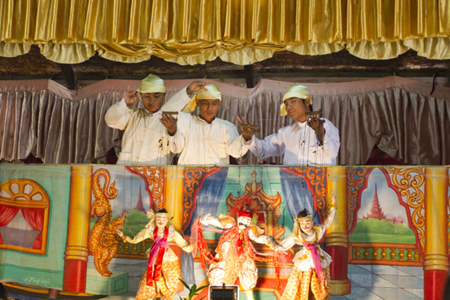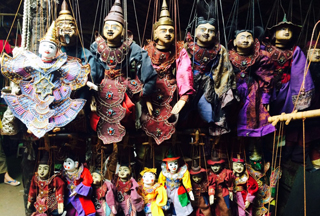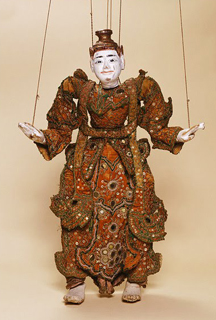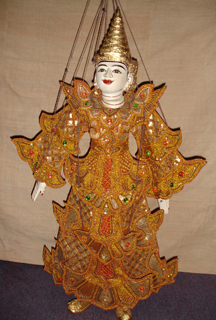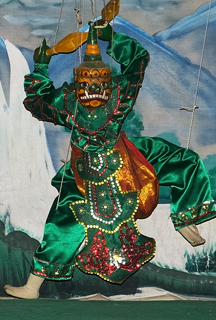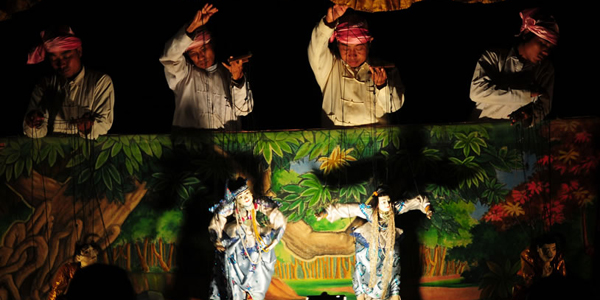Pagoda festivals in Myanmar would be incomplete without marionette show. After paddy is harvested, festivals are held because at that moment people have a surplus of time, money and look forward to a short spell of leisure. Stubble plains, just some days before, are where people worked very hard to cultivate, now become a scene of revelry. Long lines of bullock carts loaded with pilgrims, some of who carry wares to charter. This time, visitors in Myanmar tours will have a chance to witness one of the most interesting events in a year.
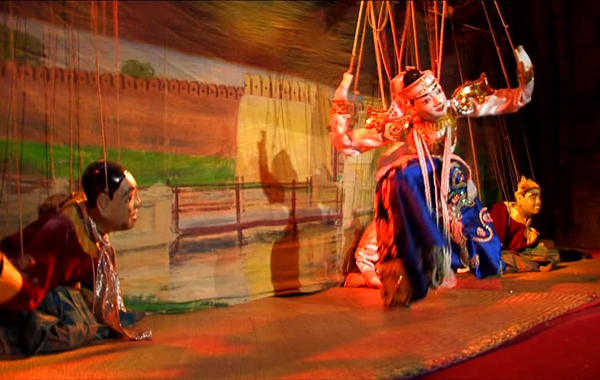
People moor their barges on the riverside, and people bustlingly gather round to see offered items. In this festival, what catches our attention first is the barge carrying the marionette troupe. The festival will soon be crowded with people. You could conveniently find out your favorite stuff as there are long lines of stalls built up. The product are very varied and copious ranging from hand woven cotton, bamboo and cane basket, mats, and made-of-toddy which come from all sizes to smallest toys things and packing cases which are woven in appealing designs. This festival boasts such characteristics like a trade faire, and the chit-chat and laughter of festival attendants add the vibrant atmosphere to the festival. Ferns wheels, merry-go-rounds, and marionette are what contribute to the uniqueness of the festival. People create a made-of-bamboo stage. Traditionally, people will not build decrees with their back to the village. This show will take place outdoors and the audiences will sit on the ground and bring their own mats.
The carving of puppets
Puppets are generally created by specialists, but sometimes they may be manufactured by some puppets-masters. Among many kinds of good Yamanay wood was preferred due to its outstanding features. This sort of wood is solid and light. Yanmany wood grown in Myanmar's highest and coolest regions could reach the height of several dozen meters. People believe that this specie has beneficial powers as a result, people use it to make sacramental thrones. In order to make puppets, craftsmen have to carefully select the suitable tree to make the puppet. Afterward, the tree will get dried. It was indeed considered a good omen that all puppets should be carved out of the same tree. The latter was then split into pieces, each of which was marked on its upper part so that the characters would not be made upside down, and again they were dried. The dried pieces were then plunged into the water. The immersed parts will be used to create male characters whereas open air parts will be used for the making of female characters.
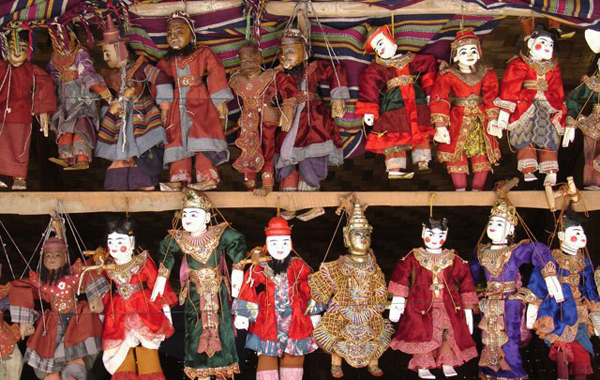
The length of head and body will be measured with the proportion of one and six, which makes a total of seven lengths equivalent to between 60 cm and one meter (the latter is quite rare due to the puppet’s weight). The arms measured half the body's length without the head, which itself measured three times the nose in length and five times the eyes in width. The ministers are among the tallest puppets and the page among the smallest. The width of the forehead, shoulders, and hips together with the delicacy of the nose, hands, and waist of female figures respected very accurate measures. These criteria were also adapted to the traditional dances that women were supposed to execute. The hair of puppets was traditionally made of real human hair.
In modern time, people replace by horse hair It was attached to little holes in the skull. Arranged in a row forming a circle, they went from the top of the forehead to the nape of the neck. Moreover, carvers distinguish Prince and Princess' eyes in onyx and white jade. The artisans use a piece which is used to stick a piece the head with shoulders and allowed a lighter animation. Due to the cloth joins, the body was articulated and animated by strings which were tied to the neck, shoulders, elbows, wrists, thighs, knees and waist (with the exception of Nat Pyet. who had a round belly). It is believed that the emergence of puppets could trace back to the 18th century. However, excavations in small villages have revealed scaled-down limbs that seem to have belonged to dolls or puppets which were made out of clay instead of wood.
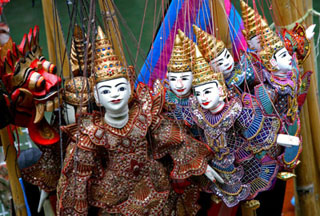
Painting and tattoos
Over the past centuries, people have used the same technique to paint puppets. In the ancient time, puppets were covered by porcelain color which could not be replaced nowadays chemical painting. People cover the puppets with a mixture made of talcum powder or lime, which contributed to a powdery substance on a spherical stone (also used to grind the Thanakha, a tree whose bark is made use of by women and children as the make-up to protect them from sunlight and mosquitoes), and water. This process will result in a kind of dough. Before being crushed and being brought to a greasy cream, Tamarind seeds will be undergone a 5-hour heating process. Later, people will produce a mixture made of these two pieces of dough. Afterward, this mixture will be used for the purposes of painting the faces of good characters.
In order to make durable painting, ten layers or so are necessary. To make these layers dry rapidly, the artisans must carry out this operation within a day and in the sunlight. In ancient time, people used a little cushion placed on the puppets' heads while they were transferred to avoid damage. They were anew entirely cleansed and painted one time a year. Owning to some mercuru oxide, a little vermilion was achieved. Evil faces were painted with the mixture created from the hinthapada and basic white painting. People paint the eyes and eyebrow in black, which was made with a mixture of soot tamar rein and fish's bile, the ngagyin (Cirrhina morigala). Despite the widespread of the use of ink in modern time, people still use vermilion to paint hands, feet and lips. They also use ink to make the circular motifs which were finally filled with grease-paint on the cheeks of pages, imitating women's and children's thanakha. The facial expressions such as joy, grief, and anger were carefully realized.
From the old time, tattoos were used to adorn or protect their bearer from the blows of misfortune. Spirits and dark forces are believed to exist by the locals. They, therefore, symbolically reproduced them onto the puppets. As Nicolo di Conti, a Venetian merchant who came to Burma in 1435 said: "All inhabitants, men, and women, decorate their flesh using an iron point that paints them in an indelible manner. Thus, they are painted for the rest of their days". The existence of tattoos could be seen on many parts the puppets’ body including the face, the chest, the pelvis, the feet, the hands, and the limbs.
Puppet Clothes and strings
Both royal and puppet clothes was made by the same material (sequins and glass pearls). The import of these sequins from India could be traced back in the 17th century. They were produced in Burma in the following years. A few years ago, in some villages, people mainly earned their livings by the manufacturing of sequins. Now, we could see the existence of families living on this sole activity in the nearby areas of Mandalay. The manufacturing process of these sequins includes several steps. Copper or brass strings were firstly rolled around a stem. Then, the latter was cut, so that small metal rings could be obtained.
Nowadays people made sequins out of plastic. As for glass pearls, people have been making them by superimposition of glass, resin and polished metal which was then colored in order to make it take the aspect of a cabochon. Before being used as shoulder-straps, wristbands and a number of decorative features for the royal characteristics (Princes, Princesses, Kings, and Nats) to wear, these "jewels" were first embroidered onto silk or velvet material and then were cut, assembled and sewed. All of the characters were formally dressed except for the hermit.
In accordance with the animators’ abilities, most of the puppets but the Naga were hung by ten to twenty strings (kyo). There would be the exception of some characters that might even have been hung by more than twenty strings. The essentially white color of these strings make invisible. Whenever the scenery became darker, the strings could turn into grey or black. The process of making these strings must be carried out with care. They were solidified and sheltered from moths. Besides, in order to make these strings disentangle easier, the locals dip these strings into a juice of the local “te” fruit for a few days. The five main strings, called "life strings" were tied to the shoulders, the spine and the temples. While strings were traditionally tied to the heels and toes of the Prince, it will not be the case of the Princess, who is not allowed to dance with open toes in front of the audience. In contrast, strings are only tied to the knees of alchemists, the page and the ogre. In order to make the eyes or mouth of the characters discreetly animated, people normally hide strings inside their body. Owning to strings going through the head, the eyes and mouth of characters then open and close. Despite of recent manufacture, the same case was applied to some jesters who could move their tongue and eyelids.
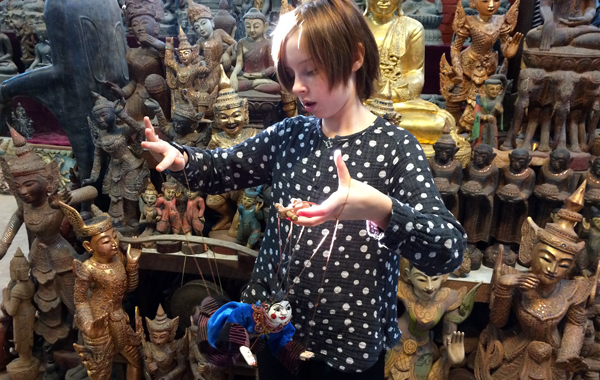
Marionette stage
The stage is soberly decorated with the exception of a green branch placed in the middle against the two and a half feet high white backdrop and a kadaw-pwe, an offering of respect. This offering tray includes two bunches of bananas and green coconut dotted with flowers wrapped in green banana leaves. Kadaw-pwe is an indispensable item in any celebrations in Myanmar.
Ritual dance
The opening part of this show is a ritual dance performed by a female marionette. It is believed that the regional guardian spirits will witness their gratitude and respect through the dance. It therefore, is formally performed. It is also a common belief that the power of the guards will scare all the dangers that may be lurking on the festival grounds away. The dance of the marionette, the artistry, and prowess of the orchestra men make this ritual dance interesting and boisterous.
Primeval forest scene
The show will go on with the dance of the animals and mythical beings including like the dragon, ogre, and zawgyi in the primeval forest. Primeval forest is believed to be the dawn of the world. The boisterous prelude music performed by the orchestra signifies chaos before the earth came into being. According to the Buddhist’s universal concept, the horse will appear first as the first emergence of planet on the firmament was Asavani, a horse’s head-shaped galaxy of stars. The scene, therefore gives the audience knowledge that the earth and the sky came into being out of the chaos. Next, there will be the appearance of the elephant stepping with grace and dignity. Afterward, the stage will soon be full of animals such as tigers on the prowl, birds in the air, and the monkey up to his antics. There will be also the present of mythical beings who contribute the fantasy, glamour and the mysterious beauty of the wilds to the show.
The play; scenery and props
Following the Primeval forest scene is marionettes show. The show traditionally took place against a scenic background which is now replaced by a white one. Only few props are used; tree branch to signify a forest, the throne conveying the idea of the king's audience hall and the couch for the boudoir. The play invariably begins with a scene of the king holding I court. This scene is hardly part of the story. This story delivered by the court scene is that after the primeval forest, there was the appearance of human society with law and I order. The lyrical beauty and the epic grandeur of the dialogue are the contributing factors to the strengths of the Myanma marionette show.
Importance of the court scene
It is a common belief that the plays would be incomplete if there is no the royal court scene with the king and ministers. Actually, the audience will be bored with the scene. However, there are some good points to open the play with this scene. In the colonial days, it was a reminder of Myanmar's sovereignty which had been lost. The glorious music of the orchestra and the song in praise of the king and his realm awakened nostalgic memories in the old who passed them on to the young.
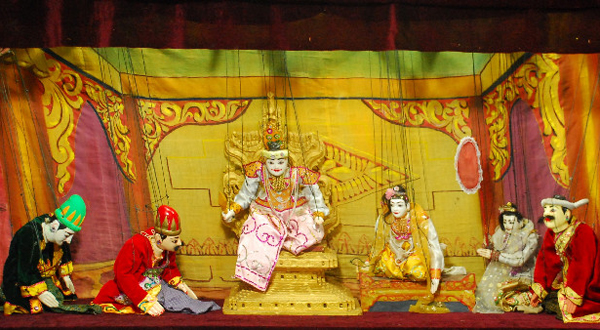
The duet dance
The court scene is followed by the most awaited hna-par-thwar which is such a lovely scene. The present of this scene actually does not contribute to the continuance of the story. There is the represent of the two leading characters of the play in the state. The scene is the blend combination of the artiste's mastery of singing, elocution, recitatives, and the music of the orchestra.
All-night performance
The marionette show is held through the night. This often makes the foreigners in awe: "How is it possible? Why all-night?" The locals in turn are surprised by the questions. They consider this a fact no matter what are the reasons. Although there were some goodwill people making efforts to make the duration of the show shorter, little success was seen. Some argues that people could find difficult in getting back their home if the show ends in the middle of the night. This argument proves it right as the locals living in surrounding villages have to travel a very long distance to join the show. They would rather stay the whole night to immerse in the fun, music, and entertainment in so prodigious manner than return their home at midnight. Also, Myanmar people are such entertainment-lovers that they are content with nothing less than the overnight entertainment. Nowadays, this overnight show has been changed in terms of leisure and easy-going ways. Although all-night shows today are much shorter, they go on and are enjoyed in both small towns, rural areas, and cities.
Presentation of the puppets
The appearance of 18 puppets could be traced back to the 18th century under the Nyaungyan dynasty. Although there is the creation of 8 additional puppets due to the 1821, these puppets are not obligatory and occasionally used depending on the companies and the plays of this repertoire. In fact, the number of puppets has its origin from a vital Buddhist work, the Abhidhama Pitaka. This book said the human body is attributed from 28 different parts, which are symbolically carved on the puppets. Shows staging an odd number of puppets were by the way avoided.
The twenty-eight puppets of the 1776 treaty are:
1- Natkadaw: medium
2- Aphyo-daw: maid of honor
3- Myin: horse
4- Myauk: monkey
5- Taw-belu: ogre or jungle demon
6- Nan-belu: ogre or city demon
7- Kyar: tiger
8- Sin-net: black elephant
9- Naga: dragon serpent
10- Garuda: mythical bird
11- Zawgyi: magician-alchemist
12- Nan Yin Wun: prime minister
13- Pyi De Yay Wun: minister of the Interior
14- Atwin Wun: general secretary
15- Myo Wun: Governor
16- Thu Nge Daw: page
17- Bayin: King
18- Mintha: Prince
19- Minthamee: Princess
20- Lu Shin daw - Than Cho: jester
21- Lu Shin daw - Than Pyet: second jester
22- Mintha-gyi: white-faced Prince Regent (good)
23- Mintha-gyi: red-faced Prince Regent (evil)
24- Thagyar Min: King of celestial spirits (Nat)
25- Nat Pyet: evil spirit (Nat)
26- Brama or Sama-deva: good spirit (Nat)
27- Ponna: astrologer (evil)
28- Ya-thay: hermit or monk
Since the 1821 edict did not make a list of the additional puppets. it is impossible to assert that the following were not anterior to the edict:
29- Kyee-to-yway or Wun-bo: parrot
30- Mi-gyaung: crocodile
31- Sin-phyo: white elephant
32- A-po-oh: old man
33- A-may-oh: old woman
34- Mi-baya: Queen
35- Sone or Meinma-gyan: witch or evil woman
36- Mote-soe or Lu-gyan: hunter or evil man This list is far from being exhaustive and according to the companies and the era. other puppets can yet be encountered such as the pig. dog. ogress. lion. owl. actor or actress.

